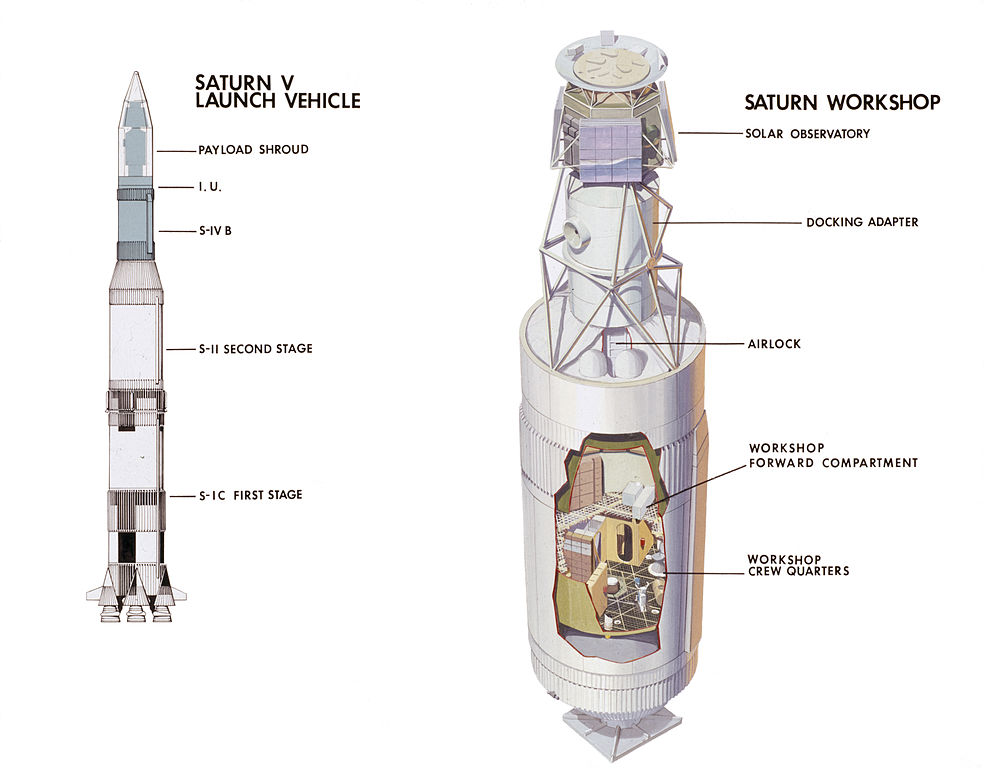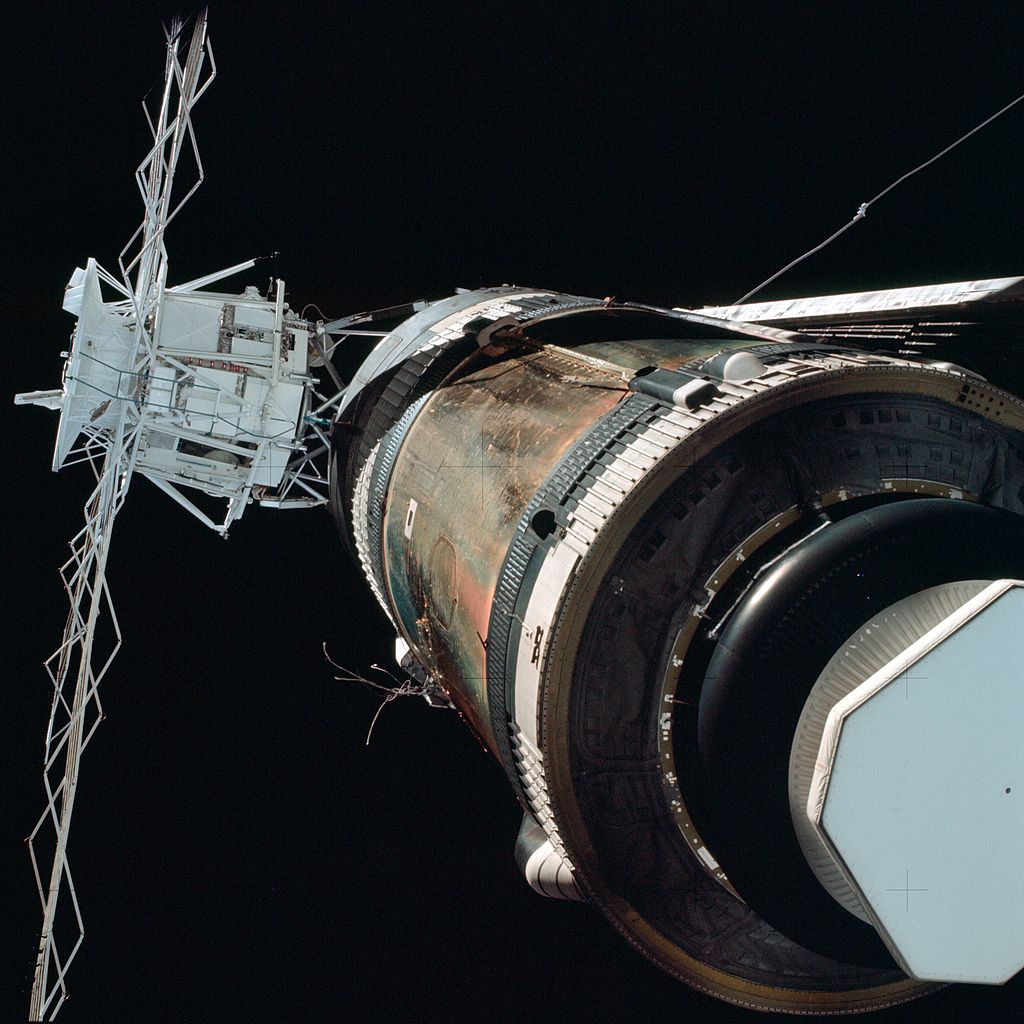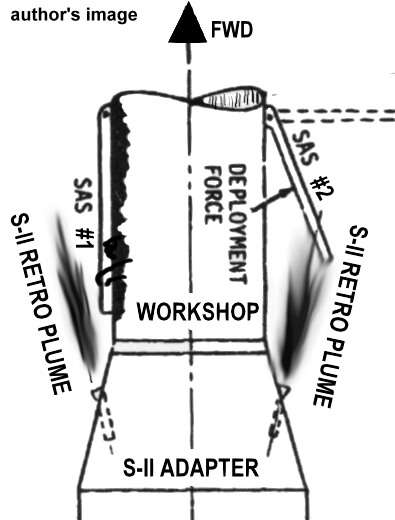When Skylab launched on May 14th, 1973 things looked good from the ground. The Saturn V 1st stage ignited, and like the Apollo launches before it, the vehicle began its flight – Americas first space station was off to what looked like a perfect beginning to its mission. After about 50 seconds or so the Saturn V carrying Skylab had flown into a thick layer of clouds over the launch site, obscuring most everyone’s view of the vehicle as it continued its flight.
Just as Skylab was passing mach 1 – the speed of sound – something strange happened in the telemetry data. The Saturn V launch vehicle began reacting to an unexpected aerodynamic force. With the vehicle obscured by clouds, no one could see what was happening – part of the space station simply tore off!

The black mass at the top of vehicle in this launch photo is the micro meteoroid shield, which was lost just a minute after this photo was taken.
This part was the micro meteoroid shield, the large black and white painted segments that covered the main body of the Orbital Workshop portion of Skylab. This component was designed in 2 main sections which would lift up just slightly from the station once on orbit, providing protection against debris in space as well as acting as an insulation barrier against the heat of the sun.
This happened due to a flaw in the design of the micro meteoroid shield. As the Saturn V passed mach 1, shock waves that were formed caused a reverse air flow pattern to flow up a small “tunnel” on the outside of the space station. The high air pressure in this area eventually found its way under the micro meteoroid shield, lifting it up just enough that the supersonic air passing around the vehicle could tear the shield off. This damaged both the left and the right solar wings of the station as it tore off.
The shield would hit the Saturn V not once but twice as it fell away – one time on the interstage portion between Skylab and the Saturn V second stage, the S-II, and another time on the interstage between the S-II and the S-IC. This second hit damaged the interstage in such a way that it failed to separate when it was supposed to. It continued into orbit along with the S-II and Skylab itself.
I’ve read conflicting reports, but given the design of the Saturn V, I’m inclined to believe this was another situation where the entire space station could have been lost. The interstage between the S-IC and the S-II on the Saturn V was designed to allow the massive 1st stage safe separation from the second stage, giving the engines on the S-II time to get to 90% full thrust. Only then, about 30 seconds after staging, would the interstage be separated. As mentioned above, for Skylab, it failed – a situation that would normally be an abort case on a manned flight – but no one knew it had happened to Skylab until after the telemetry data was studied. Signals indicated things had gone fine; all false, of course, as the micro meteoroid shield had damaged things in such a way that the interstage partially separated, just enough to release a plug that would tell the Saturn V computer that the interstage had separated when it should have. Not that there was much anyone could have done had they known it had failed to separate fully.

A diagram of Skylab as it was in launch configuration. You can see the interstage between the S-IC and the S-II clearly, as well as the general size comparison of Skylab to the rest of the rocket, listed here as “S-IVB.”
The issue is the interstage being attached would trap hot exhaust gasses from the 5 J-2 engines in the second stage – these gasses would heat up and weaken the lower structure of the S-II, possibly result in its failure, and the quite explosive loss of Skylab. Apparently reports say the vehicle was seconds away from this actually being a possibility at the time of engine shutdown!
Amazingly, Skylab made it to orbit, albeit with 2 damaged solar wings, and missing its micro meteoroid shield. Then, the S-II separated from Skylab. To do this, it used 4 retrorockets which, on the Moon missions would push the stage away as the S-IVB would ignite to take over flight. Instead, these rocket motors would push the massive S-II away from the relatively small S-IVB sized Skylab, giving it a clear orbit to deploy in.
One of those retrorockets, however, was located dangerously close to where one of the solar wings was located, now loosened from the station. The exhaust plume of this rocket tore that solar wing clear off the station, and debris from the shield tearing off got tangled up with the other solar wing, causing it to fail to deploy.
Thankfully, the rest of the station was undamaged – the payload shroud panels deployed, and the Apollo Telescope Mount could move into its home position at the “top” of the station – its four solar panels providing at least some power to the now crippled station.
Once on orbit, ground control quickly learned of just how bad off the station was. What seemed like a mostly normal 10 minute or so launch had turned out to be a near disaster. Temperatures in the station climbed well above what they should have been, risking damage to film, food supplies, and other equipment inside the Orbital Workshop. Electricity was a trickle of what it should have been. These two elements combined with the data gathered from launch told ground control the station was not in a good shape.
The launch the first manned mission, Skylab 2, planned for May 15th, would be delayed while ground control figured out just what to do. Could the station even be saved? If so, how? You can only fit so much inside of an Apollo Command Module, what can you bring up there that will allow you to protect the station from the suns rays, and how can you free a damaged solar panel with as little risk as possible to an astronaut? In the mean time, how would they keep the station alive – it was too hot to keep in the sun, too starved of power to not be aimed directly towards the sun for power generation from the solar panels.
NASA had a short amount of time to figure out what to do.
NOTE: This article is intended as a somewhat simplified re-telling of the information presented in this article along with some additional personal commentary. Images are being shared from said article where need be to demonstrate the events as they happened. Check the link out and if the book this info is from looks interesting to you, please consider purchasing it! No, this is not a sponsored post.

A crippled space station…


